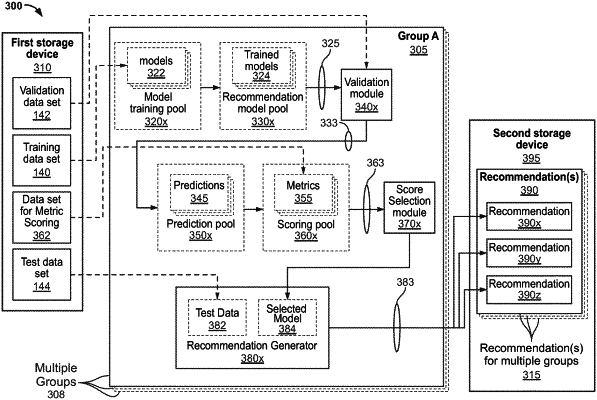| CPC G06Q 30/0631 (2013.01) [G06N 5/04 (2013.01)] | 30 Claims |

|
1. A system comprising:
a data processor associated with a computing device; and
a non-transitory computer-readable storage medium comprising instructions that are executable by the data processor for causing the computing device to:
generate one or more recommendations for one or more services or items from a plurality of groups of categories to users associated with an entity based on an indication of relevancies of metrics to the entity,
wherein for each group of one or more services or items, a respective recommendation system of a plurality of recommendation systems generates the one or more recommendations, and
wherein the plurality of recommendation systems operates in parallel for the generation of the one or more recommendations for the one or more services or items from the plurality of groups;
for each recommendation system within the plurality of recommendations systems, the generation of the one or more recommendations for the one of more services or items from the respective group comprises:
obtain, for the respective recommendation system, a training data set related to a plurality of historic user inputs associated with preferences of one or more services or items from the entity;
train, for the respective recommendation system, a plurality of models using the training data set to generate a plurality of recommended models;
apply, for the respective recommendation system, a validation data set comprising the historic user inputs to generate a plurality of predictions from the plurality of recommended models;
obtain, for the respective recommendation system, a weight of each metric of a plurality of metrics from the entity;
obtain, for the respective recommendation system, user inputs associated with user preferences of the one or more services or items;
determine, for the respective recommendation system, a relevancy score for each metric of the plurality of metrics at least based on the operations of:
selecting each metric in the plurality of metrics,
applying at least one prediction and at least one user preference to each selected metric, and
applying a weight to the selected metric to generate the relevancy score for the selected metric, the weight representing an indication of importance of the metric to the entity;
select, for the respective recommendation system, a recommended model from the plurality of recommended models based on the relevancy score of the selected metric or a combination of selected metrics; and
generate, from the respective recommendation system, one or more recommendations from the selected recommended model; and
select an optimal combination of recommendation systems from the plurality of recommendation systems that generates most relevant recommendations based on an indication of relevancies of the metrics to the entity; and
output, from the optimal combination of recommendation systems, the most relevant recommendations for the one or more services or items from the plurality of groups of categories.
|